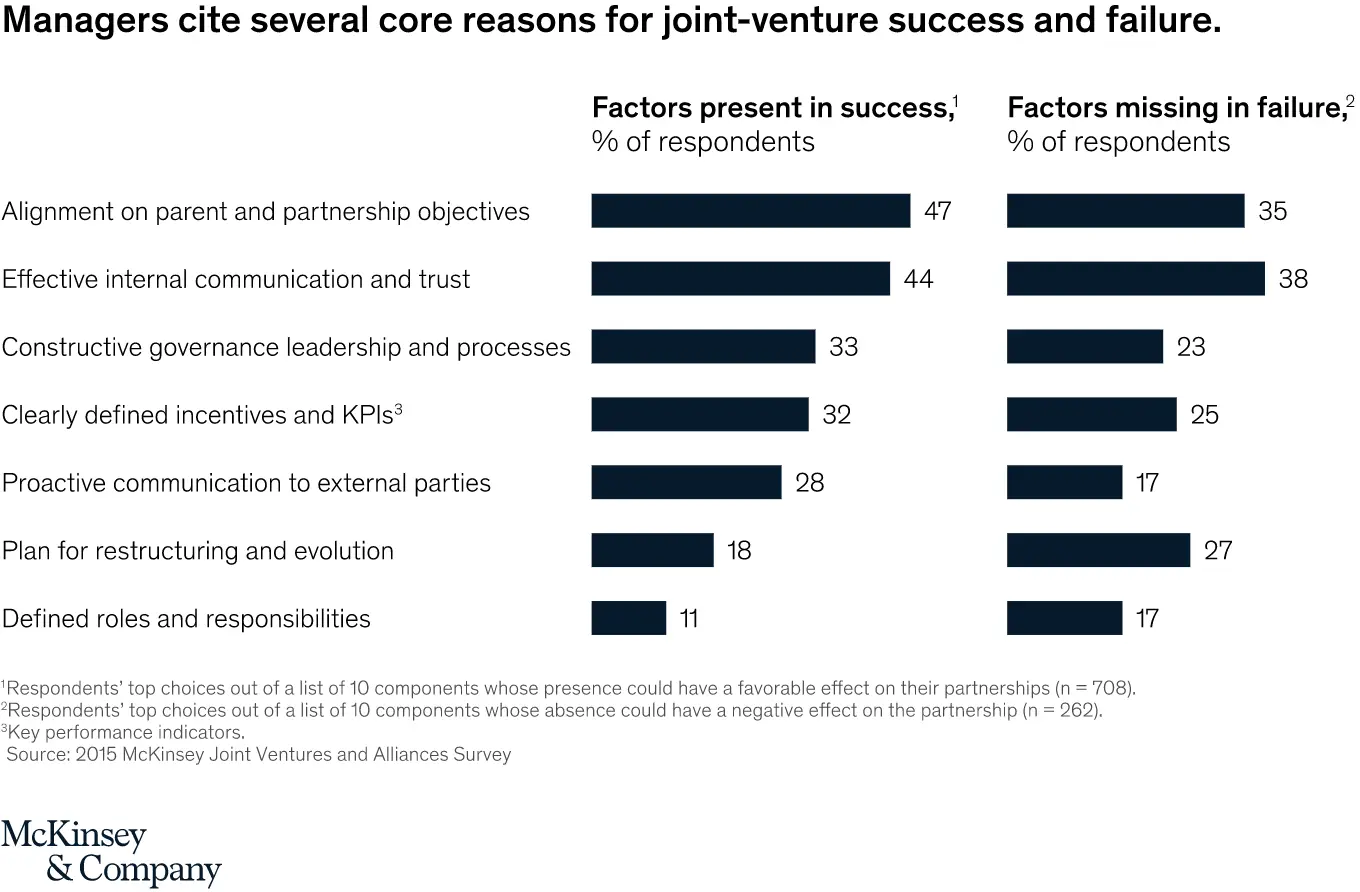How To Build Strategic Partnerships For Growth[Guide]
A business is a diverse mixture of working parts, with every department working in harmony to create profit. While it would be nice for a company to be amazing at everything, many executives find that their firm excels in certain areas but blunders in others, and they have little idea how to fix the issues. That’s where a strategic partnership comes in. They are a mutually beneficial relationship between two businesses, usually to support each other in areas where they excel. In this article, we provide some of the most effective tips on how to build strategic partnerships, so that you can form a profitable relationship.
Strategic partnerships are all about finding a company whose skills and knowledge complement your own, which makes both companies more capable and allows them to achieve great things together. If your firm produces high-quality products but fails to market them properly, you might want to look for a strategic partner with the marketing savvy to bring them to the world. In turn, you might help with their R&D and product development, to help them create a profitable, winning product. Consider the immense amount of skill and knowledge that is spread across the world’s companies, just waiting to be shared through the right agreements. A strategic partnership allows you to harness these resources to make your company more complete.
There’s other benefits too. A strategic partner has a unique perspective that can help them to see things from a different angle, revealing pitfalls and market growth opportunities that you may have missed. They can help you to enter new markets or sell on new channels, and spread the financial risk of innovation. But most importantly, they allow you to continue specialising in what you do best, with your partner supporting you in the areas that they know best.
What makes a successful strategic partnership?
It isn’t enough to know how to build strategic partnerships, you should also know what it takes to make them successful. Many of them end up on the dustheap, with both firms feeling like they’ve wasted their time. To have any chance of success of creating a successful strategic partnership, you’ll need a number of key elements:
- You both have something the other company needs—whether skills, knowledge, resources, or something else, both firms must provide genuine value to the other for the partnership to work.
- You have clear objectives—both firms know what they want out of the partnership, understand the time and effort needed to make it work, and are fully committed. This is covered in detail in the partnership agreement.
- Your values are aligned—many business decisions are made based on the cultural values of the company, which define its code of ethics and guide its employees’ behaviour. So to avoid butting heads on important decisions, the values of both companies should be close. Reviewing each other’s value statements can help with this.
- You trust each other—trust is built when each company commits to its obligations, which results in clear, measurable benefits for each.
- You communicate regularly—bi-monthly meetings are necessary to work through issues, get feedback, and report on results. This is in addition to plenty of phone calls, emails, and Slack messages in between. Keeping key stakeholders informed is vital.
- You agree on performance metrics—the success of the partnership must be regularly measured, with digital marketing metrics that show business performance.
- You like each other—every relationship (strategic or otherwise) breaks down if the two parties dislike each other. Try to bond with your strategic partners outside of work, as it can help to make the relationship fruitful.

Strategic alliance vs partnership
People often consider strategic alliances vs partnerships—but what’s the difference? A strategic alliance is similar to a strategic partnership, but tends to be focused on individual projects. For example, a strategic alliance may be formed by two companies to complete a project, with each firm using their strengths to achieve a good result.1 A strategic partnership, on the other hand, is usually an ongoing agreement between two companies who agree to share resources and knowledge to achieve long-term goals.
How to build strategic partnerships
Strategic partnerships can be lucrative for both companies, but their success takes a lot of research, planning, and hard work. True strategic partnerships—where each company signs contracts agreeing to their responsibilities—are legal agreements that you’re obliged to follow. So they aren’t to be taken lightly or rushed through. Here’s an overview of how to build strategic partnerships with the right companies.
1. Figure out what you need
Most executives want a strategic partner because they know their business is lacking in some way, and believe that it’s more profitable to find a partner to fill it rather than investing in it themselves. This gap can be almost anything related to the business, including complex processes like finance, manufacturing, or innovation, resources like IT equipment or heavy machinery, industry expertise for key areas, or valuable business contacts.
So the first thing to do is to figure out what your business needs the most. If you’re wanting to sell your services in a brand new country, but don’t have the knowledge or contacts to do so, you may benefit from finding a partner in that country. If your R&D department seems to be stuck with the same old ideas, you might seek out a company that is known for its innovation. Or perhaps you have certain goals you’re trying to achieve, and believe that it may be more efficient for a partner company to accomplish them rather than yourself.
Be clear on your company’s needs before proceeding, as this is the main reason for the partnership.
2. Figure out what you can offer
A partnership is a two-way street—you’ll need to provide genuine value to each other for the relationship to thrive. What can you offer another firm that will tempt them to become contractual partners with you? Do you have a history of producing potent ads with big returns? Maybe you have a workshop or manufacturing process that could be used to their advantage? Successful businesses tend to shine in a few areas, so identify yours, and use them as your selling point.
3. Search for partners
Now comes the tricky part—finding a strategic partner with complementary resources that are a good fit. You can search in the following places:
- Trade shows and conferences—these are a potent place for connecting with other businesses. Visit plenty of stands, watch lots of presentations, and chat to anyone and everyone to get an idea of what their business does, and whether it might suit your own.
- Your current suppliers and business associates—these are firms that you already have business relationships with, who you presumably already trust. It can be a valuable pool to dip into.
- Industry organisations or associations—these are usually bursting with talent, but can be trickier to identify. You may want to approach the people who run the association and ask if they can make any recommendations.
- Online—this is the most challenging place to find partnerships, because you know little about the companies you’re looking at, and it can be tough to get your foot in the door anyway. But it shouldn’t be discounted.
When searching for strategic partners, be sure to approach people both inside and outside of your industry. There’s a lot of shared knowledge when working with a partner from the same industry (and it may be easier to communicate too), but companies outside of your industry can give you a fresh perspective that helps you to innovate.
Finding strategic partners is usually a slow process that demands persistence—you might need to have many conversations to know whether a partnership has potential. But for your initial conversations, you’re trying to find out two things:
- Does the company have something you need, and can you offer something in return?
- Do your cultural values align?
Once you’re satisfied with the above, you can move onto the next step—requesting a formal meeting with the potential partner.
4. Set up an initial meeting with the potential partner
You’ll need to meet with the CEO and other key executives of the company to do two things:
- Pitch what you can offer
- Determine what they can offer
Go in with a solid plan that helps you to achieve these. This includes creating an exceptional pitch that blows them away, and a list of exploratory questions to figure out whether they can provide genuine business value to your company. You should also spend some time chatting informally, to better understand if you’ll work well together.
If the meeting is a success, and each party believes that they have something to offer the other, set up another meeting to discuss the partnership further, and slowly work out a strategic partnership plan and agreement.
5. Meet again (and again) to develop a partnership agreement
A partnership agreement is a complex contractual agreement that can cover a variety of areas, including:
- What work each party is undertaking
- The goals of each party
- Reporting requirements
- IP ownership
- Capital contributions of each party
- How profits and losses are shared
- How business opportunities are shared
- Exclusivity terms
- Competition terms
- Exit terms
The partnership agreement is the foundation of the relationship, and must be as accurate and fair as possible, with solicitors from both companies present. Naturally, this can take a lot of time and effort to work out, and shouldn’t be skimped on because it can be the difference between a thriving relationship or a feeble one. Each party must properly understand their obligations, and exactly how they are going to create value for each other.
6. Sign the partnership agreement, and you have a new strategic partner
Once both firms are happy with the terms of the agreement, it’s time to sign and celebrate your future success together!
Maintaining a successful strategic partnership

Once the contracts are signed, the real work begins. Successful partnerships don’t just happen. They are constantly nurtured, with each firm fulfilling their obligations to the other.
These are some of the critical elements of a profitable partnership:
- Be absolutely clear on your obligations and responsibilities—this should be worked out in the partnership agreement, but also made clear through separate policies and procedures for members of staff. Every person must know what they have to do, when they have to do it, and how it should be reported.
- Make partners a priority—you wouldn’t expect your romantic partner to stick around if you ignored them, or never lifted a finger for them. Your strategic partner must be a priority for your business. With the right attitude, it can yield prodigious profits.
- Hire people to manage the relationships—consider hiring people to manage the work between your strategic partnership, and to keep communication flowing.
- Get together socially—it’s hard to build rapport over Zoom, so take the time to meet with your partners for drinks, dinner, or other fun events. This helps to build a strong relationship where you genuinely want to do well for each other.
- Invest—you may need more tools, processes, or staff to pull the strategic partnership off. Don’t be afraid to invest in them.
That’s it! You should now have a good understanding of how to build strategic partnerships, and how to maintain them to ensure their success. Good luck!
References
- Will Kenton, 2021, Strategic Alliance Definition, Investopedia


